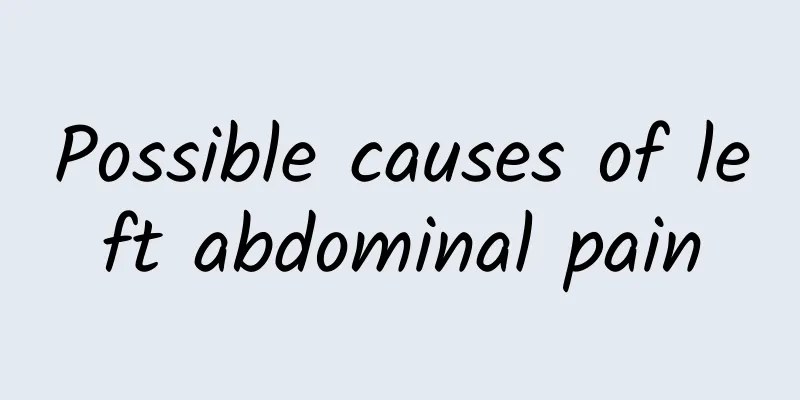Pain above the anus

|
The main cause of pain in the upper anus is anorectal diseases, such as hemorrhoids and anal fissures, which are common causes of pain in the upper anus. When this kind of pain occurs, it is best to check the rectal indications and perform an anorectal endoscopy to further determine the cause and then treat it symptomatically. Conditioning in daily life is very important. Do not exert too much force when defecating. Also, pay attention to diet and prevent constipation. 1. Non-surgical treatment Asymptomatic hemorrhoids do not require treatment; symptomatic hemorrhoids do not require radical treatment; non-surgical treatment is the main treatment. (1) General treatment is applicable to most hemorrhoids, including the early stages of thrombotic and incarcerated hemorrhoids. Pay attention to your diet, avoid alcohol and spicy foods, increase fiber foods, eat more fruits and vegetables, drink more water, change bad bowel habits, keep bowel movements smooth, take laxatives when necessary, and clean the anus after defecation. For prolapsed hemorrhoids, be careful to gently push the hemorrhoids back with your hands to prevent them from falling out again. Avoid sitting or standing for long periods of time, do appropriate exercise, take a sitz bath with warm water (which may contain potassium permanganate) before going to bed, etc. (2) Local medication has been widely used. The drugs include suppositories, ointments and lotions, most of which contain Chinese herbal ingredients. (3) Oral medications are generally used to treat varicose veins. (4) Injection therapy is more effective for grade I and II bleeding internal hemorrhoids. The sclerosant is injected around the venous plexus in the submucosal layer to cause an inflammatory reaction and fibrosis, thereby compressing the varicose veins. The treatment can be repeated after one month to avoid injecting the sclerosant into the mucosal layer and causing necrosis. (5) Physical therapy: laser therapy, cryotherapy, direct current therapy, copper ion electrochemical therapy, microwave thermocoagulation therapy, and infrared coagulation therapy are rarely used. (6) Rubber band ligation is used to tie the root of the hemorrhoids, blocking their blood supply and causing them to fall off and necrotize. It is suitable for grade II and III internal hemorrhoids, and is more suitable for giant internal hemorrhoids and fibrotic internal hemorrhoids.2. Surgery (1) Indications for surgery: Conservative treatment is ineffective, hemorrhoids are severely prolapsed, large fibrotic internal hemorrhoids are not well treated with injections, and there are anal fissures, anal fistulas, etc.; (2) Principles of surgery: The prolapsed anal cushions are repositioned through surgery, and the structure of the anal cushions is preserved as much as possible, so as to minimize the impact on the ability to control bowel movements after surgery; (3) Preoperative preparation: When there are ulcers or infections on the surface of internal hemorrhoids, conservative treatment such as laxatives and warm water sitz baths are performed first, and surgery can be performed after the ulcers have healed; bowel preparation is performed. |
<<: What to do if anal pain occurs during menstruation
>>: Pain when tightening the anus
Recommend
Breast cysts can be treated with Chinese medicine dialectics
For most female friends, the symptoms of cysts in...
What kind of soup is better for replenishing blood and nourishing the skin? Which soups can replenish blood and nourish the skin?
Many people know that women are born to bleed, so...
A few small actions before going to bed are good for health, and it is difficult to get sick
"Do you want to escape from problems? Pigmen...
Astragalus pictures
Scutellaria baicalensis is a common Chinese herba...
What should you not eat if you have herpes? You should pay attention to not eating these things in your daily diet
People sometimes get herpes for various reasons. ...
What is the health-preserving method of Chinese medicine?
When we talk about health preservation, we often ...
Is erosive hemorrhagic gastritis serious?
Many people have irregular daily diets, and such ...
How to treat left upper ureteral dilatation?
The ureter is an organ in the human excretory sys...
Small blisters on the breast
The growth of small blisters on the breast is a v...
What is a prostate cyst?
There are many common diseases among men. When tr...
How to regulate diet for flushed face
For female friends, if the face flushes, it shoul...
Do I need to stuff cotton into my tooth when filling it?
I believe that many people are concerned about de...
What foods are better for men with kidney deficiency? What foods can nourish the kidneys?
Kidney deficiency is a common phenomenon in life,...
There is a small pimple behind the ear
Some people are prone to pimples behind their ear...
How to recover quickly from a coccyx injury
The coccyx seems to have no use to the human body...









